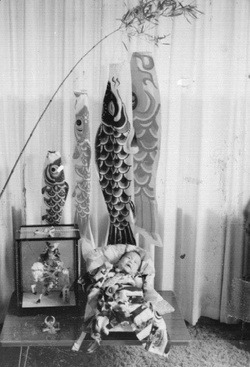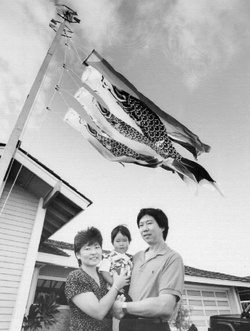>> Part 1
Unlike the elegant, orderly, and colorful setting for Hina Matsuri, the exhibit for Tango No Sekku is an artistic disaster. The arrangement has usually three levels instead of the girls’ seven to nine steps, and it is loosely set on a green carpet or a grass mat. Okay, one can call it a free form, liberal or minimalist tableaux. A heavily decorated kabuto, or the old military helmet, and a set of armor surrounded by arrows, lances and other weapons head the display. Instead of the kabuto, some people show a jingasa, or the simpler military headgear. But let’s not kid ourselves; some jingasa may be superb treasures of lacquer ware. The top tier of the tableaux may also contain some paper lanterns, small e-nobori, and assorted greenery. That is probably all the official paraphernalia. The rest of the space is filled with all kinds of musha ningyo, or warrior dolls, miniature weapons and whatnots, depending on the imaginative choices of parents and boys, their ability to acquire them, or the care given to the inherited family treasures.

Japanese Americans also keep the tradition. Portrait of an infant boy dressed in kimono and laying in infant chair on a small folding table next to a Boy's Day doll under four cloth koi nobori hanging from a bamboo branch in front of curtains in Hilo, Hawaii, 1980. The samurai doll riding on a white horse is enclosed in a glass case at L. Gift of the Ogata and Murakami Families, Japanese American National Museum (96.337.3)
If the family has been able to save the old warrior dolls through generations of loving care, your eyes will feast on some of the most exquisite, legendary characters of the Japanese tradition. Of course, nothing will compare with the lavish displays created during the years close to the Meiji Restoration. Those were really extravagant. To control lavishness, the Tokugawa government decided to pass the ultimate-in-bureaucratic idiocy, a law that forbade parents from giving boys ANY toys on Tango no Sekku. In commoner families, only the grandparents would be allowed to give a little toy spear to a child on his first celebration. Of course in the traditional Japanese independent thinking, people developed ways to violate the miserly law, and the displays became even more elaborate. When Emperor Meiji decided that he had had enough of the shogunates, the parsimony law became finally null and void.
In art galleries dedicated to Japanese antiques, such as L’Asie Exotique in New York and Alan S. Pate’s Antique Japanese Dolls in Montana, you’ll find some of the most eye-catching examples of what might have been used in the Tango no Sekku displays of yore. Yoshitsune and his sidekick Benke will be individually represented or teamed up at the Battle for the Gojo Bridge. Jimmu Tenno, or a richly costumed kabuki depiction of his figure, may also attract you. To further lure you, there will be Empress Jingu and her minister Takenouchi no Sukune, the treacherous and cruel Yoritomo, and the revered figure of Taiku Hideyoshi. Kintaro and Momotaro, almost indispensable parts of modern displays, will also attract you, and so will Iyeyasu, dressed in full regalia. Then of course, Hachiman, Kato Kiyomasa, Oishi Kuranoske,1 Urashima Taro, and even Takeda Shingen will also summon your attention. Excited? One only needs to be ready with between $1,900 and $16,000 to acquire any of these splendid beauties.2
What will surely make both sides of your mouth water are the musha mounted figures, particularly those which the creator’s ingenuity has enriched with fastidious detail. Here you’ll see armor with miniatures piece by piece carefully set by hand, and a kabuto, meticulously showing every essential detail. The figure’s mane, either silk or real human hair, is carefully embroidered thread by thread to look like a warrior’s coiffure. The fighter is armed with a miniature sword that slides in and out of his lacquered scabbard, and he holds a pennant rich with original details. The horse is dressed in the most elaborate battle gear. Every detail insures that the Yamato spirit is forcefully conveyed.
Less dominant figures in a modern Tango no sekku display may be a battle drum, a warrior’s fan and a saihai, the commander’s baton. In the bottom tier, someone may place a white steed, all by himself or facing a well-striped tiger; and the figure of Shoki, the devil expeller. The white stallion is the product of the union between a dragon and a royal mare; the tiger is the symbol of all that is powerful, constructive or destructive. And Shoki, the loyal Chinese scholar, in his trousers, black boots and cap, is the top enemy and most effective destroyer of evil imps and oni. Not surprisingly, some modern displays may also be honored by the presence of the freshest Robot Boy or a miniature model of the most recent Red Roadster Bugatti. Oh, boys!
Tango no sekku is also a day for munching special delicacies. One must partake of the sake seasoned with crushed iris petals, for the plant’s cleansing powers, of course, and to lengthen your life. The boys must eat some chimaki dango, the dumplings that help one be always clever and wise. Well, this is done to an extent, for in the traditional Chinese lore, the dango are also eaten to help fecundity. Since wisdom and fecundity aren’t necessarily complementary virtues, please allow some exceptions to the benefits of chimaki. At any rate, the day cannot be the day without eating Kashiwa mochi, another source of wisdom and cleverness. Here the mochi, filled with delicious sweet black beans, is wrapped in kashi, or oak leaves, a symbol of strength, manliness and endurance.

A couple hold their son under a koi nobori flying in front of their house for Boy's Day in Hawaii, 1994. Gift of the Ronald and Kay Fukumoto Family, Japanese American National Museum (96.340.1)
If instead of wasting the day indoors the boys should prefer to go outside to fight some imaginary battles, it is okay, as long as they chivalrously protect each other from harm. Perhaps at night, before retiring, the kids may spend a few meaningful moments with Dad and the rest of the clan, enjoying stories of survival, accomplishment, and heroism from the family’s past, or even of the presence of the Japanese in their newly adopted environment. Give it a try!
Other small details may be important, too. The tokonoma, or your own living room where the Boys’ Day display has been set, should have the presence of the iris; not just for the beauty of the flowers, but for the legendary mystical properties attributed to it. Then, there are those who would never let the day go by without taking a bath in water enriched with macerated iris leaves. Coming to think of it, Japanese industriousness may have already created a bath product to take the place of crushed iris, neh?
Now, if you don’t see at least a dozen koi flying high from the flagpole at your Japanese and Nisei community center on May 5th, don’t blame me. I tried to excite everybody about the beauty of Boys’ Day lore. So, Happy Tango No Sekku! Omedetto gozaimasu!
Note:
1. Yoshio Oishi, the leader of the 47 Ronin of the Chushingura team.
2. You may want to check the websites www.antiquejapanesedolls.com, www.lasieexotique.com, and www.17.plala.or.jp, just to drool by. You can also search on Yahoo.com or Google.com, typing “musha ningyo,” and enjoy the excellently documented 3,028 sites available.
*This article was first appeared in the East San Gabriel Valley’s Japanese Community Center’s “Newsette” in May 2008.
* * *
The major kodomo-no-hi celebration in the Los Angeles area this year takes place at the Japanese American Cultural and Community Center, downtown Los Angeles, on Saturday May 15, 2010, from 10AM to 4PM, with all kinds of activities for our young persons. JACCC is at 244 S. San Pedro Street. Los Angeles, CA 90012. Phone: 213.628.2725.
Many local gaku-en and Japanese American community centers will indeed remember the day, at least with the flying colors of youth, the koinobori. For other areas, please check Discover Nikkei’s Events or consult www.japanese-city.com.
© 2008 Edward Moreno





